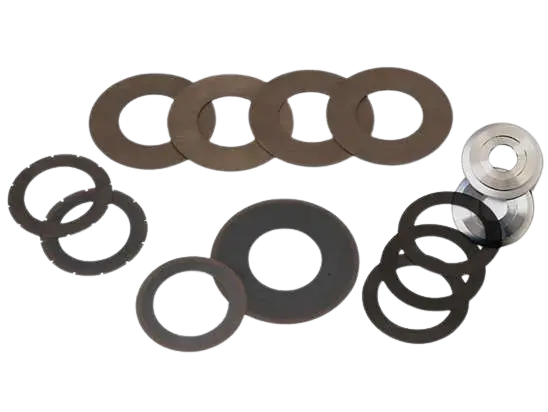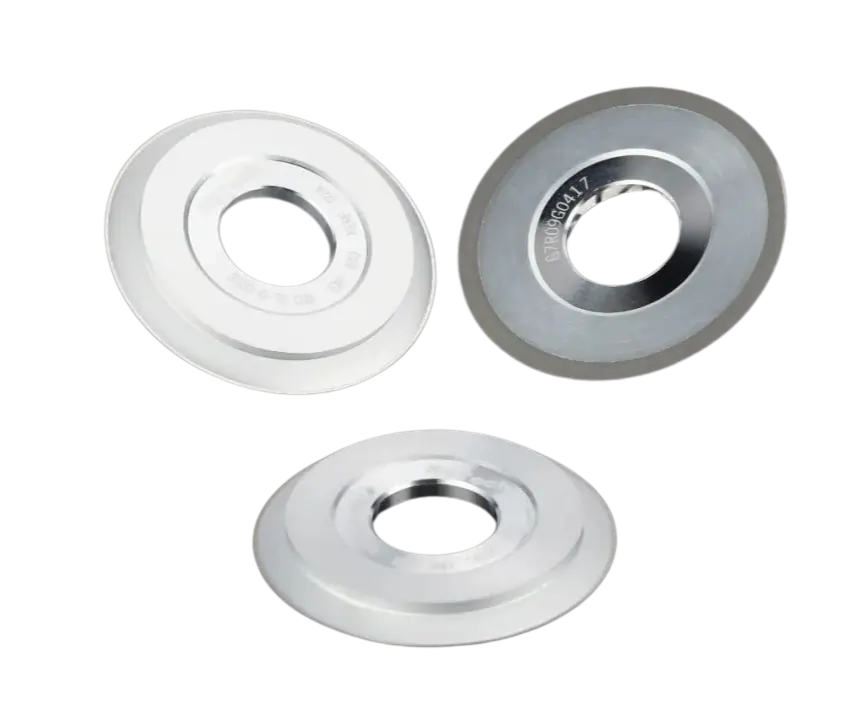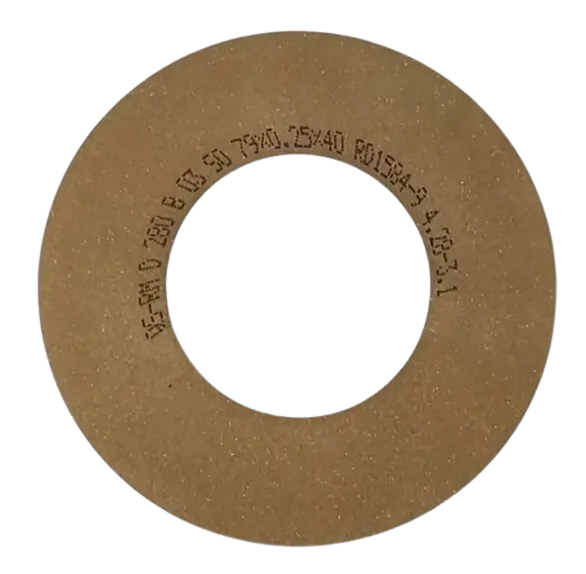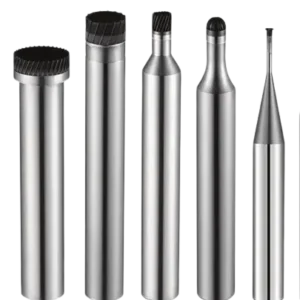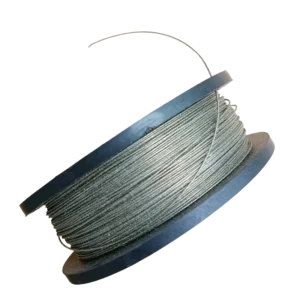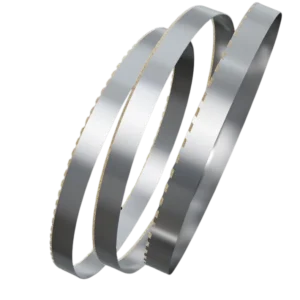Description
Dicing Blade: Key Tool in Semiconductor Manufacturing
Dicing blades are crucial tools in semiconductor manufacturing, primarily used to precisely cut large wafers into individual small chips. The precision of the cutting process directly affects the quality and performance of the chips, making the technology level of wafer dicing blades vital to the entire semiconductor industry.
Wafer Dicing
Wafer dicing is a critical process in semiconductor manufacturing, using high-speed rotating dicing saw to cut the wafer along preset cutting paths into single chips. Here’s a detailed breakdown of wafer dicing:
On a single wafer, there are typically hundreds to thousands of chips connected together, with gaps of 80um to 150um between them. This gap is known as the saw street. The process of separating each chip with independent electrical properties is called dicing or cutting. Currently, mechanical diamond cutting is the mainstream technology in the dicing process. Diamond dicing blades rotate at high speeds of 30,000 to 40,000 RPM to cut the saw street portions of the wafer. Simultaneously, the worktable holding the wafer moves linearly at a certain speed along the tangent direction of the contact point between the blade and the wafer, with the silicon debris produced by the cutting washed away by deionized water (DI water). Depending on the wafer size it can cut, the mainstream dicing machines in the semiconductor industry are divided into 8-inch and 12-inch dicing machines.
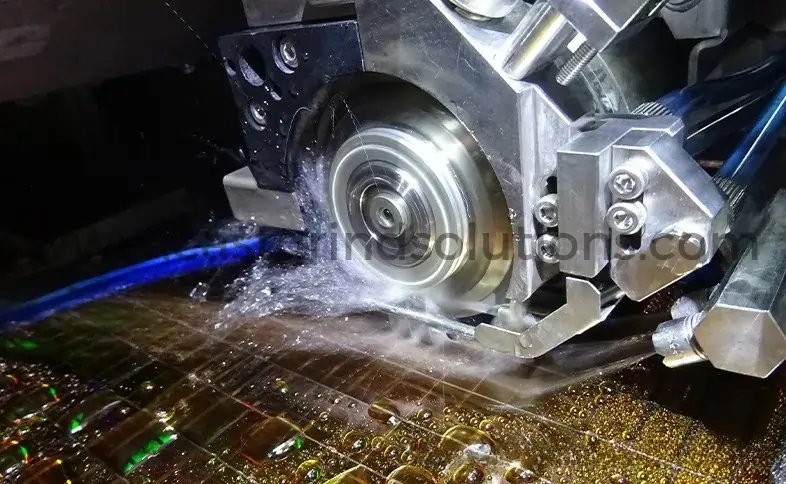
Cutting Path Principle
Cutting Path Definition: The cutting path, also known as the cut path or saw street, is the preset route on the wafer for the dicing machine blade to cut through. These paths are designed in both horizontal and vertical directions to ensure the blade accurately cuts along these routes.
Cutting Path Function: The design of the cutting path enables the Dicing blade to precisely cut the wafer without damaging the chips themselves. Once the Dicing sawcuts through all the cutting paths, the chips on the wafer become separated, preparing them for subsequent packaging processes.
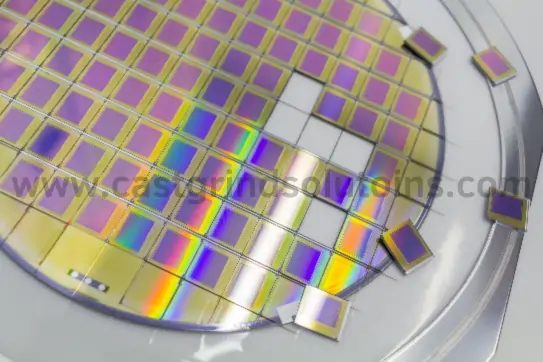
Working Principle of Wafer Dicing Blades
A wafer dicing blade is a high-precision cutting tool used to cut large wafers into smaller chips. Its working principle includes the following steps:
Positioning: First, the wafer is fixed on the worktable of the dicing machine and accurately positioned using an optical system. The accuracy of this positioning directly affects the cutting precision and yield.
Dicing: The wafer saw blade, usually made of diamond or other high-hardness materials, performs the cutting through high-speed rotation. During the cutting, the feed rate and rotation speed of the tool need to be controlled to ensure smoothness and precision.
Cleaning: A significant amount of debris and dust is generated during cutting, which must be cleaned by a cleaning system to prevent contamination and damage to the chips.
Inspection: After cutting, the chips need to be inspected to ensure their size and shape meet the requirements.
Applications of Dicing saw Diamond Blade
Diamond dicing saw blades are widely used in various stages of semiconductor manufacturing, especially in the following areas:
Chip Manufacturing: In chip manufacturing, Diamond dicing saws are used to cut large wafers into small chips, a critical step affecting chip yield and performance.
Optoelectronic Devices: In the manufacturing of optoelectronic devices, such as LEDs and lasers, Diamond dicing blades are used to cut optoelectronic materials. These devices demand high precision and surface quality from the cutting process.
Sensors: In sensor manufacturing, wafer dicing blades cut various sensing materials, like MEMS sensors and pressure sensors, requiring high-precision diamond dicing blade for stringent size and shape requirements.

Technical Specifications
Types of Dicing Blades
Metal Bond Dicing Blades
These dicing blades are made from high-quality diamond micro-powders and metal bonds, characterized by high diamond retention, wear resistance, and long service life, suitable for precision cutting of electronic and optical components.
Resin Bond Dicing Blades:
Made using thermosetting resin as the bond and diamond abrasives, resin dicing blades feature elasticity, which maximizes cutting quality, making them ideal for processing difficult materials like glass and crystalline materials.
Electroplated Nickel-Based Dicing Blades:
Produced using advanced electroforming technology, these Wafer dicing saw blades are high-performance, high-quality cutting tools suitable for semiconductor wafers, resistors, ceramics, and semiconductor packaging materials.
Hubbed Dicing Blades:
Designed with Nickel bond and diamond grit, hubbed dicing blades offer high stability, cutting accuracy, and efficiency. They have excellent chip evacuation and cooling performance, with high durability and less deformation, making them suitable for deep cutting and slotting.
| Type | Blade Shape | Diameter(mm) | Kerf Thickness(mm) | Grit Size | Thickness Tolerance | Diamond Concentration |
| Metal bond dicing blade | 1A8, 1A8S | 5-200 | 0.05-4 | 100#-3000# | ±0.002 / ±0.005 | 30,60,90,110,130,150 |
| Resin bond | 1A8, 1A8S | 40-160 | 0.05-4 | 100#-3000# | ±0.002 / ±0.005 | 30,60,90,110,130,150 |
| Nickel Bond | 1A8, 1A8S | 40-120 | 0.02-0.5 | 100#-4000# | ±0.002 / ±0.005 | |
| Hybrid Bond | 1A8, 1A8S | 10-150 | 0.05-2 | 100#-3000# | ±0.002 / ±0.005 | 30,60,90,110,130,150 |
| Hubbed Dicing Blade | 3A1, 3A1S | 50-80 | 0.01-0.15 | 320#-5000# | ±0.002 / ±0.01 |
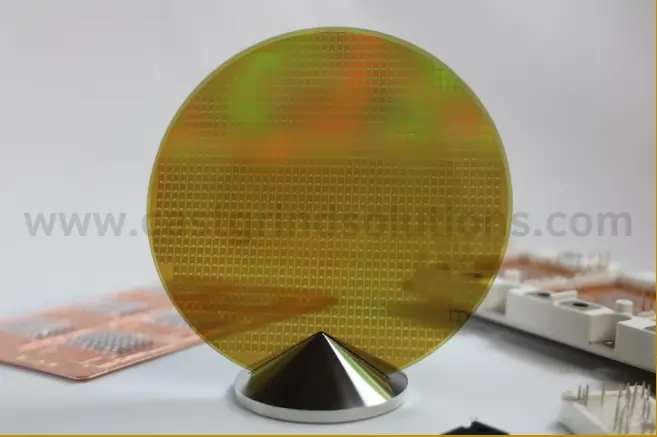
At Cast Grind Solutions, we specialize in providing high-quality Dicing Blades with standard dimensions and parameters. Should you encounter any issues related to wafer dicing, our dedicated team of engineers is readily available to assist you. We pride ourselves on offering exceptional customer service and support. Please do not hesitate to reach out to our technical experts for any concerns or inquiries regarding your dicing needs.Key Features of High-Quality Dicing Blades.
Key Features of High-Quality Dicing Blades:
Ultra-Hard Material Particles: The Wafer dicerblade surface is evenly distributed with high-hardness diamond particles providing strong cutting force and wear resistance.
Precision Bond: Diamond particles are fixed on the blade through a special bond, with the choice of bond significantly impacting cutting performance and wafer dicing saw life.
Optimized Blade Design: The thickness, diameter, and shape of the dicing blade are meticulously designed for different cutting tasks, reducing wafer damage and enhancing cutting efficiency.
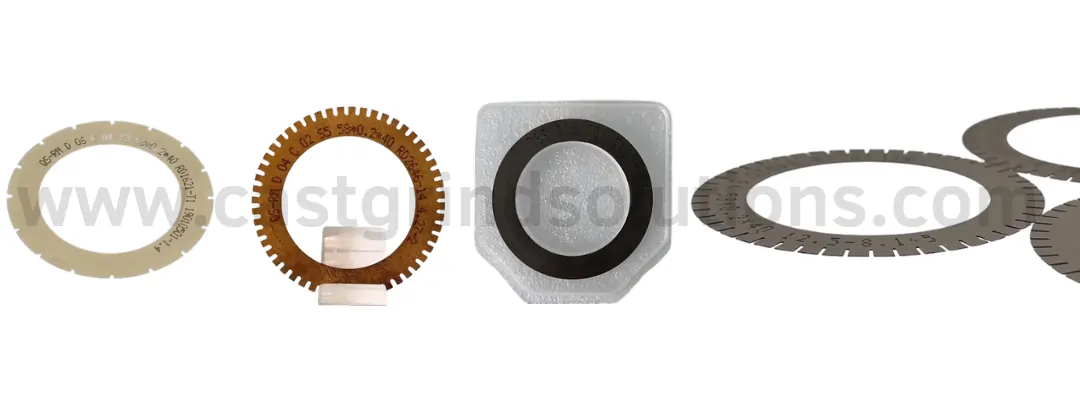
Features
How to Choose High-Quality and Suitable Dicing Blades
Dicing blades are primarily made of synthetic resin, copper, tin, nickel, and synthetic diamond. They can be divided into hubbed and hubless types, suitable for processing various materials in the semiconductor industry. Selecting the appropriate dicing blade depends on several critical factors including diamond grit size, concentration, bonding strength, blade dimensions, and thickness.
Impact of Diamond Grit Size on Diamond Blade Dicing:
Coarse Diamond Grain Size Dicing Blade:
- Wider kerf, effectively removing, more debris and reducing silicon powder accumulation.
- Larger contact area with the binder, higher resistance, more efficient cutting, and less wear.
- Larger contact area with the material, producing more chipping, resulting in lower cutting quality.
Fine Diamond Grits Dicing Blades:
- Smaller contact area with the material, producing less chipping or none at all.
- Narrower kerf, removing less debris, potentially leading to silicon powder deposition.
- Smaller contact area with the binder, lower resistance, less efficient cutting, and more wear.
Impact of Binder Strength in Dicing Blades:
High-Strength Bond:
- Higher toughness, less likely to break, more durable.
- Higher wear resistance, less blade regeneration, lower product quality.
- Greater resistance, slower feed rate, lower efficiency.
Low-Strength Binders:
- Lower resistance, faster feed rate, higher efficiency.
- Higher wear, more blade regeneration, higher product quality.
- Lower toughness, more likely to break, less durable.

Effect of Diamond Concentration in Dicing Blade;
High Diamond Concentration:
- More kerfs, effectively removing more debris, reducing silicon powder residue.
- Lower diamond grit load, less cutting resistance, faster feed rate, higher efficiency.
- Smaller kerf, producing less debris, easier cleaning, higher quality assurance.
- Less binder, lower blade toughness, more likely to break, higher product scratching risk.
Low Diamond Concentration:
- More binder, higher blade toughness, less likely to break.
- Fewer kerfs, removing less debris, more likely to leave silicon powder residue.
- Higher diamond grit load, more cutting resistance, slower feed rate, lower efficiency.
Cast Grind Solutions offers a range of diamond concentrations (50/70/90/110/130), covering customer needs and helping select the most suitable concentration.
Effect of Dicing Blade Thickness:
Thick Dicing Blades:
- Less vibration, higher product quality.
- Higher strength, less likely to break.
- Larger contact area, higher resistance, more debris, slower feed rate, higher pollution risk.
Thin Dicing Blades:
- Smaller contact area, lower resistance, faster feed rate.
- Less vibration, higher product quality.
- Lower strength, more likely to break.
Effect of Dicing Blade Diameter:
Dicing Blades with Big Diameter Size:
- Longer lifespan.
- Lower strength, slower feed rate, more likely to break.
- More vibration, prone to wobbling, producing wavy cuts.
Dicing Blades with small diameter size:
- Shorter lifespan.
- Higher strength, faster feed rate, less likely to break.
- Less vibration, less prone to wobbling, higher quality.
Optimizing these factors is essential in selecting a high-quality and suitable dicing blade for various applications in the semiconductor industry. Proper selection ensures a balance of efficiency, durability, and product quality.
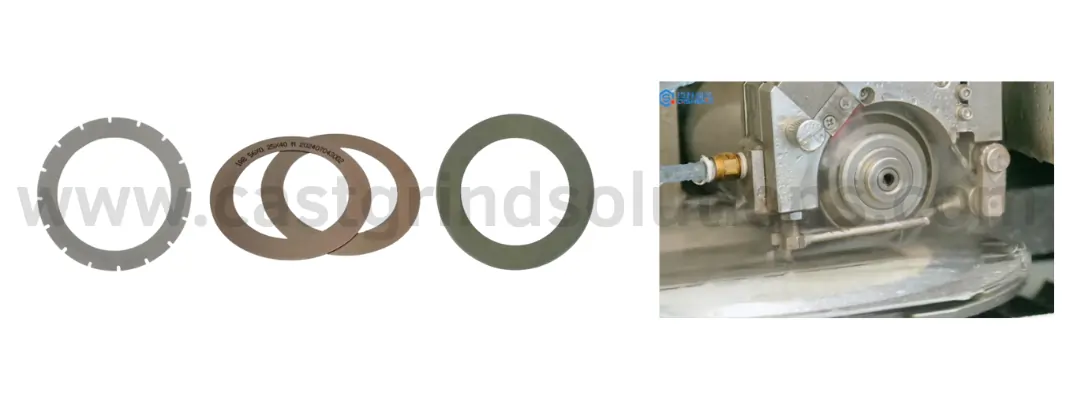
Application
Dicing Blades Applications:
Semiconductor Industry:
- Wafer dicing
- Chip encapsulation cutting
Electronics Manufacturing:
- Precision cutting of electronic components
- Substrate cutting
Optical Industry:
- Processing of optical lenses and components
Mechanical Parts:
- Cutting of precision mechanical components
Application Areas for Different Bond Dicing Blades:
Metal Bond Dicing Blades: Optical devices, ceramics, ferrite, quartz, IC packages (BGA), optical communication devices.
Resin Bond Dicing Blades: Quartz, glass, lithium niobate, crystals, IC packaging (QFN, DFN).
Electroplated Nickel Bond Dicing Blades: Silicon wafers, compound wafers, ceramic substrates, metal oxide ceramics, lithium niobate, tantalum niobate, Faraday, packaging materials, PCB boards, QFN, BGA.
Hubbed Dicing Blades: Semiconductor materials (BGA, LGA, LED beads, diodes), optical glass (optical filters, sapphire glass), ceramics (quartz cover plate, ceramic substrate), metal plates (cemented carbide, tool steel).
By understanding the detailed aspects of wafer dicing and the various types of dicing blades used, companies can ensure higher efficiency, precision, and quality in their semiconductor manufacturing processes. This knowledge is crucial for optimizing the performance and lifespan of the dicing blades, contributing to better manufacturing outcomes.

